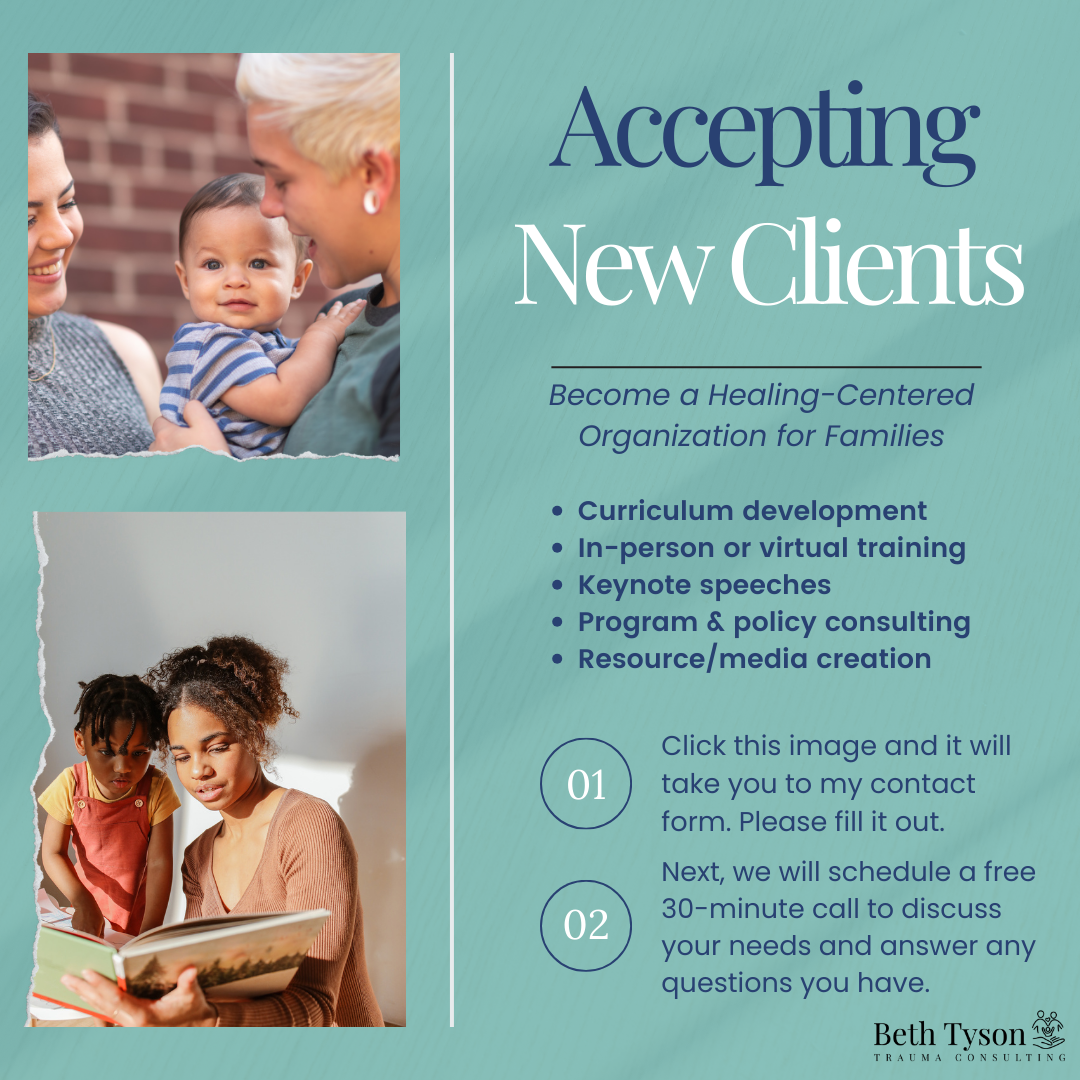Introducing a New Approach to Supervised Visits
When children enter foster or kinship care, they lose more than just their home and their parents. They also lose:
- Connection to their culture/religion/rituals
- A sense of belonging
- Their role in the family or community
- Friends, teachers, coaches, mentors
- Important items
…Which are critical for identity formation, development, and mental health in children.
Foster care is more than just a change of address. It’s often a profound disruption to a child’s sense of self and their ability to trust the world around them. At the same time, foster/kinship care is sometimes needed to provide a safe home for children while the parent(s) work to improve their lives. In my experience inside the child welfare system, children are not removed from their parents without significant and substantiated abuse and/or neglect.
To keep children safely connected to their kin and biological family while they are in foster care, the child welfare system requires them to attend supervised visits. The goal of these visits is to mitigate some of the losses mentioned above and maintain the parent-child relationship so that the children can eventually reunify with their biological families. Supervised visits are also an opportunity for bio parents to show they are capable of caring for their children safely.
But, What Exactly is a Supervised Visit?
In the United States, supervised visits are court-mandated meetings between a child and their parent or siblings after separation due to safety concerns in their home. These visits are supposed to take place under the watchful eye of a third-party supervisor, whose job is to ensure the child’s safety while documenting the interaction for the courts. The information gathered by the supervisor is then used to inform the judge and child welfare professionals about the status of the parent-child relationship so they can make decisions about reunification.
But, talk to any foster parent and you will quickly learn that supervised visits can also be a confusing and potentially retraumatizing experience for children who are forced to spend time with people who hurt them. In some cases around the country, children have been abused during supervised visits.
For example, in 2024, a New York City Comptroller’s audit uncovered alarming statistics: between 2020 and 2023, there were 2,154 substantiated cases of abuse and neglect involving foster children, with over 75% occurring during visits with their biological families. This is unacceptable.
New York highlights significant safety concerns associated with supervised visitations. Comptroller Brad Lander emphasized the government’s fundamental duty to protect these children, criticizing both the Administration for Children’s Services (ACS) and family courts for not fully acknowledging this responsibility. The audit suggests that inadequate supervision and a hasty push for family reunification often overshadow critical safety considerations, leading to tragic outcomes.
To make things worse, many families who need supervision are unable to access it. It was reported that as of September 2024, 28 of New York’s 62 counties lacked access to supervised visitation programs, and existing programs were often under-resourced, oversubscribed, or financially inaccessible to many families (Women’s Bar Association of the State of New York [WBASNY], 2024).
If New York is anything like the rest of the country, this scarcity of services further exacerbates the challenges in ensuring child safety during visits with biological parents.
How to Improve Reunification Efforts With a Healing-Centered Approach
Let’s take a minute to bring in some hope for the future. I want you to imagine a world where families that require supervised visits are not just monitored for safety but also have supervisors or “Family Time Facilitators” who model conscious parenting skills, recognize and respond to the symptoms of trauma and can intervene before conflict arises.
This is the reality I create through my Healing-Centered Family Time model, which includes books, training, and a curriculum grounded in trauma-responsive care, attachment theory, child development, and cultural respect to build programs that nurture healing, connection, and growth.
The term “healing-centered” was coined by Dr. Shawn Ginwright, a scholar and activist in the field of social justice and youth development. He developed the concept as a response to trauma-informed care, advocating for a broader framework that focuses not only on managing trauma but also on promoting healing, resilience, and well-being.
While the intention behind supervised visits is to support the family towards reunification, the reality is that they often feel more like an evaluation than an opportunity for healing. If the priority truly is the reunification of the family unit, we are setting families up to fail in the current paradigm.
Many children in foster care even find the term visit to be a painful trigger that emphasizes the separation from their families (Mitchell & Kuczynski, 2010). This reaction occurs because the word visit becomes intertwined with the distressing emotions and experiences children endure before, during, and after these interactions, amplifying their sense of loss and instability. Not to mention the message “supervisor” or “supervised” passes along to parents.
This is why child welfare professionals, advocates, and caregivers are increasingly reframing these interactions as “family time,” coined by child welfare advocate Dr. Marty Beyer. Research suggests that this seemingly minor shift can have a profound impact on children’s emotional well-being and the success of reunification efforts (Beyer, 2008).
Family Time: A Critical Tool for Attachment or a Safety Risk?

Research shows that “family time”, also known as supervised visits, plays a critical role in preserving attachment and reducing the trauma of family separation when these interactions are positive. Maintaining regular, safe contact with parents helps children feel more secure and less anxious while in foster care (Haight et al., 2001). It reassures them that they are still loved and part of a family, even if they can’t live together at the moment.
Without a positive connection to bio parents through visits, children face a higher risk of experiencing long-term emotional and psychological harm (Mitchell & Kuczynski, 2010).
But it’s not just about having time together, it’s about how that time is framed, facilitated, and experienced. When children and parents feel like they are being observed and judged, the focus shifts from connection to performance. In contrast, when the interaction is framed as healing-centered family time, it becomes an opportunity to nurture relationships, build trust, and support healthy attachment.
How the Words We Use Can Help
The language we use shapes how we perceive experiences. Calling it a supervised visit suggests a procedural requirement. Something mandated and monitored. It implies a lack of trust in the parent and the child. In contrast, healing-centered family time centers the child’s experience and underscores the importance of connection, belonging, and emotional safety.
And this isn’t just about semantics. Research supports this approach. Studies show that when family time is framed as a positive, relational experience rather than an evaluative one, reunification rates increase and placement disruptions decrease (Dougherty, 2013).
When parents and children can focus on bonding rather than feeling scrutinized, they are more likely to build the trust and confidence needed for a successful reunification (Haight et al., 2001).
This understanding guided my approach when writing my upcoming children’s book to support children in foster care, Sullivan Goes to See Mama. In the book, the main character attends his first supervised visit with his mama, and it brings up his BIG emotions. Throughout the book, I intentionally avoided the word visit, recognizing how triggering it can be for children and families in the system.
Tips for Healing-Centered Family Time

Reframing supervised visits as family time is an important first step, but true change requires a healing-centered approach to how these interactions are facilitated.
Here’s what Healing-Centered Family Time can look like:
1. A Safe, Welcoming Environment: Avoid sterile, office-like settings. Opt for spaces with soft seating, toys, books, and calming colors to help children feel at ease. If this isn’t possible, help the setting feel child-friendly by hanging their drawings on the walls.
2. Prepare Children Emotionally: Let children know what to expect before, during, and after family time. Predictability reduces fear and increases psychological safety.
3. Focus on Connection, Not Compliance: Family Facilitators encourage bonding activities depending on the child’s developmental ability such as reading together, playing a game, mirroring activities, or making a meal, rather than focusing solely on parental behavior.
4. Support Emotional Expression: Family time can bring up complex emotions for children, bio parents, and foster/kinship parents. Sadly, some children don’t feel safe with their parents, and family time can be retraumatizing. Supervisors need to be trained in healing-centered approaches that validate feelings, offer healthy coping strategies, and identify symptoms of trauma so they can intervene.
5. Maintain Consistency: Regular, predictable family time helps children feel secure. Inconsistent or last-minute cancellations can trigger feelings of abandonment leading to behavioral challenges at home and school. This is a common problem I encountered when working with foster and kinship families. The stress caused by canceled visits can be mitigated by preparing the child with a plan A and plan B. “Plan A is we visit with your dad today. If that doesn’t happen for some reason, what should our plan B be?” Giving them a choice is imperative to helping them feel a level of control over what happens in their life.
6. Culturally Responsive Care: Family Facilitators respect the parenting norms of various cultures and refrain from judging parents based on their own expectations or beliefs about what parenting should look like.
7. Strengths-Based: Family Facilitators adopt a strength-based approach, partnering with parents as collaborative allies rather than imposing a hierarchical or adversarial dynamic. Their goal is to empower families by recognizing and building upon their existing strengths, fostering mutual respect, and working together toward healing and growth.
8. Positive Endings: Transitions can be difficult, especially for people with trauma. A short goodbye ritual, like a special handshake or favorite song, can help children and parents feel more secure until the next family time. If a child isn’t comfortable hugging goodbye, fist bumps, high fives, and even imagining a hug can be encouraged.
The Benefits of Family Time Done Right

When family time is trauma-informed, it becomes a powerful tool for healing. Research highlights several key benefits:
- Stronger Parent-Child Bonds: Positive family time strengthens attachment, making reunification more likely and more stable (Haight et al., 2001).
- Improved Emotional Regulation: Children who experience consistent, nurturing family time demonstrate better emotional well-being and fewer behavioral challenges (McWey et al., 2010).
- Faster, Safer Reunification: Parents who engage in quality family time are more likely to meet case plan goals and reunify with their children successfully (Dougherty, 2013).
- Reduced Placement Disruptions: Children who maintain strong family ties are less likely to experience multiple placements, which can further traumatize them (Mitchell & Kuczynski, 2010).
It’s Time for Change
If we truly want to support children and families in the child welfare system, it’s time to rethink how we frame these experiences. It starts with the words we use and training supervisors on healing-centered and trauma-responsive parenting. Children don’t just need supervision. They need love, safety, and connection.
That’s the heart of my new children’s book, Sullivan Goes to See Mama. By avoiding the word visit, I model a more compassionate approach that centers on children’s emotional well-being. These moments shouldn’t feel like a procedural obligation, they should feel like a chance to reconnect, heal, and strengthen the bonds that matter most with the support families need.
What Do You Think?
Should we rethink how we approach supervised visits? You can email me at beth@bethtyson.com to share your thoughts. Interacting with you helps me stay motivated to keep publishing these newsletters. Creating this content for free is challenging, but the interaction with you makes it all worth it. Please say hi!
Resource of the Month
Download your copy of my free Healing-Centered Family Time Tip Sheet

This tip sheet was created by Beth Tyson Trauma Consulting. Please give proper credit when sharing with others. Thank you!
Pre-order My New E-Book Today!

Guess what!?
Today I logged into my account and discovered Sullivan Goes to See Mama hit #1 as a New Release e-book thanks to you!
I’ve been creating Sullivan Goes to See Mama: A Story to Help Children Navigate Supervised Visits, for a year and a half because I really wanted to get it right for the kids who read it. Few achievements feel better than taking an idea and bringing it to life in a tangible way, even if it takes way longer than expected!
I am so grateful for your guidance about the cover and contents of this book, which helped to make it the perfect resource for social workers, therapists, kinship/foster families, and school counselors serving children who attend family time. I truly couldn’t have accomplished this without your encouragement and support! Thank you for coming on this journey with me.
I’d like to give an extra special shout-out to Lisa Duff, from Childrens Aid and Family Services who guided me from the beginning on how the story could make the greatest impact on children in care, and Ana Beltran from Grandfamilies and Kinship Support Network, for endorsing my new book. You’re the best!
Sullivan Goes to See Mama is the second book in a series of stories about a Koala and his Grandma who are a grandfamily (aka kinship family). In my first book, A Grandfamily for Sullivan, we tackled the tough emotions that arise when a child suddenly has to live with relatives or grandparents due to safety issues with their biological parents. In Sullivan Goes to See Mama, we help this same grandfamily navigate family time (aka supervised visits) with compassion and trauma-informed skills.
Sullivan Goes to See Mama will be available on Amazon as an e-book and paperback on April 9th! Stay tuned to my social media and subscribe to my Childhood Trauma Newsletter in the top right corner of my homepage to be invited to the virtual launch party.
________________________________________________________________________________________
What’s New with BTTC?
It’s been a busy start to 2025! I’ve been working closely as a subject matter expert with the leadership team at Pennsylvania CASA on a custom training curriculum we are developing for their volunteers. I can’t wait to see the positive impact it will have on children in foster care across PA (my home state).
- Last week I presented at the Pennsylvania School Counseling Association Virtual Conference on ambiguous loss in foster and kinship families.
- In April, I will host a workshop on preventing and healing childbirth trauma for the Tower Health Maternal Child Health Conference. Childbirth trauma is a specialty focus of mine because of my lived experience during the perinatal period.
In between consulting work and webinars, I’ve also been working on my book, Trigger-Free Parenting™, which will teach adults how to recognize and address their parenting triggers and childhood wounds so they can stop the cycle of intergenerational trauma and heal from the past.
Announcing Healing-Centered Care for Organizations
You may have noticed from this newsletter that I’m taking the trauma-informed approach to the next level! My NEW healing-centered approach integrates trauma-responsive care, attachment theory, child development principles, and cultural respect to design organizations and programs that nurture hope, healing, and lasting resilience.
I am accepting new consulting clients and speaking opportunities for this fall and winter. Click the image below and fill out the contact form so we can discuss your goals to become a healing-centered organization for children and families!
What I’m Reading – Positive News Only!
Good news is hard to find, so in this section, I’ve curated a list of articles and research to bring positivity and hope to your life.
- This one is good news because it can lead to new forms of treatment: New Research on How Trauma is Passed Down Through Generations
Favorite Quote of the Month
Thank you to Tina Payne Bryson, Ph.D for this beautiful quote! All of Tina’s books are fantastic, and she just released a new one called The Way of Play. You can learn more about her and find links to her resources on her website above.

________________________________________________________________________________________
In Closing…
As we continue to advocate for safe and nurturing spaces for children, all the environments children spend time in must be centered around healing. By fostering empathy, consistency, and emotional safety, we can create powerful opportunities for connection and growth.
Thank you for being part of this journey toward improving the lives of children and families. Together, we can make a difference, one supportive interaction at a time.
If someone sent you this newsletter, you can subscribe in the top right corner of my home page. You can also join my private Facebook group, The Trauma Toolkit: Trauma-Informed Care for All Children.
I love you and I will continue to provide you with hope when you struggle to find your own.
With compassion and gratitude,
Beth





